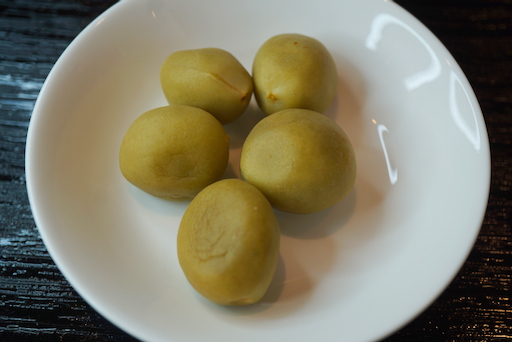Somehow my wife found a YouTube video of this recipe and I
follow the link to the recipe. The next day which happened to be Sunday, I made this bread. Although I followed the recipe and baked at 400F for 20 minutes, it was a bit over done (I used "intense heat" setting for the oven and the baking stone was in place. Next time I will bake this bread at 350F). The surface was nicely crunchy (essentially "fried" with butter).
The melted Mozzarella cheese made nice layers.
We started enjoying this bread as soon as it came out of the oven and it was still steaming. Since this was evening, we had it with a glass of Napa Cabernet. Within an hour the loaf had been reduced by 2/3's to the the size shown below. If you are wondering 'was the bread good' this should say it all. This was sort of modified pizza or focaccia and yes, it was really good.
This recipe came from the blog "
Baking and cooking with Ninik".
Ingredients:
Dough:
250g (2 cups) all-purpose flour/plain flour
5g (1-1/2 tsp) instant yeast
25g (2 tbsp) sugar
1/2 tsp salt
42g (3 tbsp) unsalted butter, melted
125ml (1/2 cup) warm milk
1 egg, whisked
Flour for kneading, if necessary
250g lactose-free fresh Mozzarella cheese (125g of each) (I just used cow milk fresh Mozzarella) .
Slice into small pieces.
Other cheese could be used if Mozzarella isn't available.
Garlic Scallion butter:
2 tbsp softened butter
1 tsp minced garlic
2 tbsp chopped scallions
1/2 tsp salt
Mix well
A sharp blade or regular knife.
Egg to brush the edge, if you are using.
Freshly cracked black pepper
Method for the dough:
In a mixing bowl, stir all the dough ingredients into a soggy dough.
Transfer to the counter, use flour if necessary to fold the dough with your fingers, fold, and press to guide the dough into a ball.
Put the dough ball on a baking tray (or we can use a round baking pan/pizza pan).
Cover until almost doubled (#1). After the dough expands, flatten with hand into a circle (#2).
Using a sharp blade, score the dough crisscross style (#3). Brush with egg at the edges if you like.
Spread garlic butter on the surface evenly (#4). Mark again the scored with a spoon for easier putting the cheese.
Insert pieces of Mozzarella cheese to fill the scored dough (#5). Add freshly cracked black pepper on top.
Bake at 200°C (400°F) preheated oven, top-bottom heat, for 20 - 25 minutes. An oven may vary.
During baking, you might find the butter leaking out to the baking tray (#4) (My oven appears to be hotter, I will bake it at 350F next time).
Best to eat warm to get the stretchy melting cheese. (Although, believe me, it is mighty-fine even when not piping hot.)
I think the scallion butter really made this bread special. The scallions became caramelized in the butter. The dough itself was very tender and almost slightly sweet. It made a nice contrast to the crunch of the crust and the toasted cheese. Wine and this bread, what else do you need? I will try it again for sure.
Version #2: The first version of this bread did not last long so fairly soon I made a second version with some various tweaks to hopefully improve an already pretty good final product. I decided to include my notes as an addendum to this blog. One of the changes I made was to score (cut) the loaf after I spread on the garlic onion butter as seen below (instead of before as suggested by the original recipe). This way, the cuts stayed open and it was easier to stuff them with the cheese.
Cheese stuffing is still a bit tedious but easier than with the previous version.
Another change was that I lowered the temperature to 350F. The original recipe did say the temperature may vary based on the oven. The oven I use is a convection oven and may run a bit hot. As shown below the loaf came out much better.
As before we had this with a glass of red wine. As before the bread was great and the changes I made were an improvement. The cheese was better distributed and cooking at the lower temperature resulted in a better texture to the bread. It was much more tender with an almost cake like crumb that was very pleasing. As before the scallions caramelized beautifully and permeated the flavor throughout. As before, the only problem with this bread is that it pulls a pretty quick disappearing act. It's hard to resist going back for just one more piece--just another little one.

































